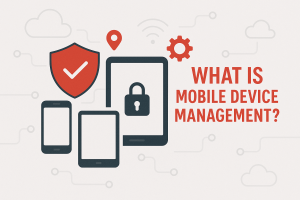Hybrid cloud technology has become a cornerstone for businesses seeking to leverage the best private and public cloud environments. Companies achieve greater flexibility, efficiency, and scalability by combining on-premises infrastructure with cloud services.
In this blog, you will learn about the top hybrid cloud providers leading the market, their unique offerings, and how they contribute to the evolving landscape of cloud computing.
Takeaways
- Discover the leading hybrid cloud providers.
- Understand the strategic advantages of hybrid cloud solutions.
- Explore future trends in hybrid cloud technology.
What is a Hybrid Cloud?
A hybrid cloud is an advanced cloud computing model that integrates on-premises data centers (often called private clouds) with external public cloud services, orchestrated to operate cohesively. This model empowers organizations by ensuring seamless data and application mobility across private cloud infrastructure and public clouds facilitated by cloud service providers.
The innovation and technology behind a provider’s hybrid cloud solutions are crucial. The best providers offer advanced features like artificial intelligence (AI), machine learning capabilities, and seamless integration between environments.
A company’s market presence and global reach indicate its reliability and ability to support businesses worldwide. Leading providers have extensive data center networks and offer global support and services.
Customer feedback and satisfaction levels are integral for assessing the quality of a provider’s hybrid cloud services. High customer satisfaction rates often correlate with superior service and support.
1. Amazon Web Services (AWS)
Amazon Web Services (AWS) is a global leader in hybrid and multi-cloud solutions, seamlessly connecting on-premises systems with public cloud infrastructure. Its vast global network ensures high availability, disaster recovery, and secure data management for businesses of all sizes.
With powerful migration tools, flexible pricing, and advanced security, AWS simplifies cloud adoption while offering full control across hybrid environments. Trusted by enterprises worldwide, it remains a top choice in the hybrid cloud landscape, alongside Microsoft, Google, IBM, and Oracle.
Key Feature
AWS allows you to run native cloud services on-premises with AWS Outposts and connect your data center directly to the cloud using AWS Direct Connect. This bridges private infrastructure with AWS’s global cloud, enabling unified operations.
What You Can Do with AWS Hybrid Cloud Solutions:
- Extend Cloud Services On-Premises
Run services like EC2, EBS, and RDS in your own data center with the same APIs and tools used in the AWS cloud. - Simplify Application Migration
Migrate workloads without rearchitecting, using tools like AWS Migration Hub and Application Migration Service. - Enable Low-Latency Edge Computing
Use AWS Local Zones and Outposts for real-time applications in gaming, healthcare, finance, or media. - Enhance Security & Compliance
Maintain sensitive workloads on-prem while meeting data residency and regulatory requirements, all with built-in AWS security. - Manage Everything from One Console
Control both on-prem and cloud resources through a unified dashboard using AWS Systems Manager.
Pros:
- Delivers native AWS services on-premises
- Deep tool ecosystem (e.g., EC2, S3, RDS) available locally
- Low latency for edge workloads
Cons:
- Expensive for small to mid-sized enterprises
- Limited customization outside the AWS ecosystem
2. Microsoft Azure
Azure delivers a unified hybrid cloud experience by extending its cloud services directly into your on-premises infrastructure. It’s built for seamless integration with Windows Server environments, strong security, and multi-cloud flexibility.
With support for multiple programming frameworks and edge computing, Azure helps businesses run, scale, and manage apps across private data centers and public cloud, making it a top choice for hybrid and multi-cloud strategies.
Key Feature
Azure Arc extends Azure services and management to any infrastructure—on-premises, multi-cloud, or edge, giving users a single control plane to manage resources across diverse environments.
What You Can Do with Azure:
- Run Azure services anywhere (VMs, Kubernetes, databases—even on non-Azure infrastructure)
- Centralize governance with unified policy, identity, and security controls
- Modernize legacy apps using containers and Azure DevOps tools
- Deploy AI, analytics, and SQL databases in hybrid environments
- Scale on demand with seamless resource provisioning across cloud and data centers
Pros:
- Seamless integration with on-premises Windows Server and Azure Stack
- Strong hybrid identity and security tools via Active Directory
- Enterprise-grade support and compliance certifications
cons:
- Complex pricing models
- Steeper learning curve for multi-cloud orchestration
3. Google Cloud Platform (GCP)
Google Cloud empowers businesses with Anthos, a secure, open platform to manage apps across public cloud, on-prem, and other providers. With built-in AI, strong data tools, and a pay-as-you-go model, GCP supports innovation while keeping hybrid and multi-cloud operations efficient and cost-effective.
Key Feature:
GCP’s hybrid and multi-cloud platform that lets you run applications seamlessly across on-prem, Google Cloud, and even other public clouds like AWS and Azure, all with a single management interface.
What You Can Do with GCP
- Deploy apps anywhere with containerized Kubernetes-based architecture
- Modernize legacy systems without full migration
- Manage multi-cloud environments from a unified dashboard
- Leverage Google’s AI/ML tools to power advanced analytics
- Ensure strong security with zero-trust architecture and continuous compliance
- Scale effortlessly across global data centers with low latency
Pros:
- Kubernetes-native architecture for true multi-cloud and hybrid setups
- Strong container management and microservices capabilities
- Supports workloads across AWS, Azure, and on-prem
Cons:
- Requires deep technical expertise
- Less mature enterprise support compared to AWS and Azure
4. IBM Cloud
IBM Cloud offers powerful hybrid cloud solutions that unify public, private, and on-prem environments. Known for enterprise-grade security and AI-driven insights through Watson, it helps businesses modernize confidently while protecting sensitive data.
Key Feature
IBM Cloud stands out with its deep hybrid cloud capabilities powered by Red Hat OpenShift for container orchestration and IBM Watson for AI-driven insights. This enables businesses to build, deploy, and scale applications across on-prem, public, and multi-cloud environments with enterprise-grade security and automation.
What You Can Do with IBM Cloud:
- Run AI-powered workloads with built-in data and analytics tools (Watson, SPSS, etc.)
- Modernize legacy systems using containers and microservices
- Ensure regulatory compliance in highly regulated industries like finance and healthcare
- Automate DevOps pipelines for faster development cycles
- Manage hybrid environments seamlessly across public and private clouds with centralized control
Pros:
- AI and analytics integration via Watson
- Strong legacy system integration
- Industry-specific hybrid cloud compliance (finance, healthcare)
Cons:
- Perceived as more suited to large, legacy-heavy enterprises
- Limited third-party integrations
5. Oracle Cloud
Oracle Cloud is designed for enterprises running complex workloads. Its hybrid cloud solutions combine cloud flexibility with on-premises control, ideal for businesses that need both.
What sets it apart? Smart automation. From databases to app deployment, Oracle Cloud minimizes manual tasks and boosts reliability. Seamless integration with Oracle’s ERP, database, and business tools makes it easy to migrate and optimize mission-critical systems, fast, secure, and scalable.
Key Feature
Oracle Cloud stands out with its Autonomous Database, a self-managing, self-securing, and self-repairing cloud data platform powered by AI and machine learning. It minimizes human error, automates routine tasks, and ensures maximum performance with minimal intervention.
What You Can Do with Oracle Cloud:
- Automate database tuning and security without manual configuration
- Run enterprise apps (like Oracle ERP, HCM, SCM) seamlessly across hybrid or multi-cloud setups
- Ensure consistent high performance and uptime with built-in fault tolerance
- Control data location and compliance with flexible deployment options (public cloud, on-premises, or dedicated regions)
- Accelerate analytics and reporting with integrated data warehousing tools
Pros:
- Best for Oracle-heavy environments (databases, apps)
- Flexible deployment behind customer firewalls
- Integrated security and performance tools
Cons:
- Less flexible for non-Oracle workloads
- Smaller developer ecosystem
6. VMware
VMware makes hybrid cloud adoption easy by integrating smoothly with your existing on-premises infrastructure. Its solutions offer consistent operations across private and public clouds, helping businesses manage multi-cloud environments without disruption. Ideal for enterprises wanting flexibility, control, and security, without starting from scratch.
Key Feature
VMware’s standout hybrid cloud feature is its unified platform that lets businesses run, manage, and move applications seamlessly across private data centers, public clouds (like AWS, Azure, Google Cloud), and edge environments, all with consistent infrastructure and operations.
What You Can Do with VMware’s Hybrid Cloud Solution:
- Run Legacy & Cloud-Native Apps Together: Modernize without rewriting apps by running both legacy and containerized workloads side by side.
- Move Workloads Without Refactoring: Shift VMs and workloads across clouds with zero code changes using vMotion.
- Enable Disaster Recovery & High Availability: Replicate data and systems across environments with built-in backup and failover capabilities.
- Unify Operations & Security: Manage everything from one console (vCenter), with enterprise-grade security and centralized policy control.
- Accelerate Multi-Cloud Strategy: Integrate easily with major cloud providers while maintaining operational consistency.
Pros:
- Ideal for enterprises with existing VMware environments
- Broad partner support (AWS, Azure, Dell, Google Cloud)
- Consistent operations across clouds
Cons:
- Licensing and management complexity
- Performance dependent on vendor integration
7. Cisco Systems
Cisco offers powerful hybrid cloud solutions built on its world-class networking and security expertise. It ensures seamless, secure connections between on-premises and cloud environments, with advanced threat protection and streamlined migration tools.
With centralized management and performance optimization, Cisco helps businesses transition to the cloud with confidence, balancing agility, control, and security across their IT infrastructure.
Key Feature
Cisco excels in connecting, securing, and automating hybrid cloud environments through its software-defined networking (SDN), multi-cloud observability (AppDynamics), and zero-trust security (Duo, Umbrella) solutions.
What You Can Do with Cisco’s Hybrid Cloud Solutions:
- Securely connect on-premises infrastructure to public and private clouds
- Monitor and optimize performance across cloud and edge environments in real time
- Automate IT operations with policy-based controls using Cisco ACI and Intersight
- Enable zero-trust architecture across users, devices, and applications
- Simplify cloud-native app delivery with Kubernetes and container management tools
Pros:
- Best-in-class for secure networking and cloud connectivity
- Deep integration with Kubernetes, VMware, and OpenStack
- Trusted brand for mission-critical environments
Cons:
- Focused more on networking than full cloud stack
- Limited native cloud application services
8. Dell Technologies
Dell Technologies delivers agile, scalable hybrid cloud solutions backed by powerful infrastructure and a close VMware partnership. With advanced servers, storage, and networking, Dell ensures high performance and resilience across workloads.
VMware integration enables smooth app migration, unified management, and faster deployment, making Dell a strong choice for businesses seeking simplicity, control, and efficiency in hybrid cloud environments.
Key Feature
Dell Apex offers scalable, pay-as-you-go infrastructure that delivers cloud-like flexibility on-premises. It enables businesses to manage workloads across data centers, public clouds, and edge locations, all from a single console.
What You Can Do with It:
- Deploy and scale infrastructure on demand without heavy upfront investment
- Run mission-critical apps in a secure, low-latency environment
- Extend cloud services to the edge for real-time data processing
- Streamline IT operations with centralized hybrid cloud management
- Optimize costs using usage-based billing tailored to actual consumption
Pros:
- Pay-as-you-go infrastructure consumption model
- Deep enterprise hardware + cloud integration
- Excellent support for edge use cases
Cons:
- Primarily focused on Dell infrastructure
- Limited global reach compared to hyperscalers
9. Hewlett Packard Enterprise (HPE)
Hewlett Packard Enterprise (HPE) delivers flexible, secure hybrid cloud platforms built on open standards. Its edge-to-cloud approach processes data closer to its source, enabling faster insights and smarter decisions.
With advanced security, automation tools, and seamless orchestration, HPE helps businesses manage and scale hybrid environments efficiently, maximizing performance, compliance, and value across cloud and on-prem systems.
Key Feature
HPE GreenLake – a pay-as-you-go hybrid cloud platform that brings the flexibility of public cloud to on-premises infrastructure.
What Users Can Do with HPE GreenLake:
- Run cloud services locally in their own data centers with cloud-like scalability
- Manage workloads across edge, private, and public cloud from a single control plane
- Speed up app development and deployment with built-in DevOps tools
- Control costs with usage-based pricing and avoid overprovisioning
- Maintain data sovereignty and compliance by keeping sensitive workloads on-site
- Access AI, ML, storage, and analytics tools without migrating to a public cloud
Pros:
- Strong on-prem-to-cloud service delivery
- Broad workload support including AI/ML, SAP, and databases
- Usage-based pricing and operational flexibility
Cons:
- Implementation may require vendor support
- Interface and reporting tools less intuitive than some competitors
10. Alibaba Cloud
Alibaba Cloud offers a reliable hybrid cloud solution that connects on-premises systems with global infrastructure. It supports smooth cloud migration, global expansion, and consistent performance, backed by powerful AI and machine learning tools to turn data into insight and innovation.
Key Feature
Alibaba Cloud’s on-premise hybrid cloud platform mirrors its public cloud services, offering full-stack capabilities (compute, AI, big data, container services) within a private infrastructure.
What Users Can Do
- Run mission-critical apps in regions with strict data residency laws (e.g., China)
- Build and manage hybrid environments with unified control across on-prem and public cloud
- Deploy scalable AI and analytics workloads locally
- Ensure regulatory compliance with in-country data storage and encryption
- Optimize costs with flexible pricing in bandwidth-intensive environments
Pros:
- Strong in Asia-Pacific with excellent local compliance
- Full-featured hybrid cloud stack (AI, analytics, containers)
- Competitive pricing and solid enterprise security
Cons:
- Limited presence in Western markets
- Language and support can be inconsistent
- Smaller global partner and developer ecosystem
11. Nutanix
Nutanix offers a powerful hybrid multicloud platform built on hyperconverged infrastructure (HCI). It unifies app and data management across on-prem, cloud, and edge, with one-click simplicity, built-in automation, and seamless scalability.
Key Feature: Unified Hybrid Cloud Platform
Nutanix offers a single, integrated platform that combines virtualization, storage, networking, and cloud services, allowing businesses to run workloads seamlessly across on-premises infrastructure and public clouds (like AWS or Azure) with centralized management.
What You Can Do with Nutanix
- Run apps anywhere — Deploy and move applications across private and public clouds without refactoring.
- Simplify IT operations — Manage VMs, containers, storage, and backups from one console.
- Scale on demand — Add capacity instantly without downtime using hyperconverged infrastructure (HCI).
- Reduce costs — Eliminate traditional hardware silos and only pay for what you use in the cloud.
- Boost resilience — Built-in data protection, disaster recovery, and security controls across all environments.
Pros:
- Hyperconverged infrastructure built for hybrid and multicloud
- Simple, unified management interface
- Strong virtualization and database workload support
Cons:
- Less public cloud integration than AWS, Azure, or GCP
- May be overkill for smaller deployments
Hybrid Cloud: Trends, Innovations & Challenges
Hybrid cloud is evolving fast, with AI, automation, and security leading the charge. Expect smarter workload placement, predictive analytics, and streamlined management via unified dashboards and orchestration tools.
But it’s not without hurdles. Security, compliance, and integration remain major concerns. To succeed, businesses must invest in strong governance, encryption, and skilled IT teams to bridge on-prem and cloud environments.
The future? Smarter, safer, and easier hybrid cloud operations, if you’re prepared.
Choosing a Hybrid Cloud Provider? Start with the Experts at Adivi
Selecting the right hybrid cloud provider is critical for the success of hybrid cloud initiatives. Businesses should consider factors such as the provider’s track record and expertise in their industry vertical, as well as the compatibility of their solutions with existing IT infrastructure.
Additionally, evaluating the specific features and services providers offer, such as disaster recovery capabilities, hybrid networking options, and support for containerization technologies, can help businesses make informed decisions. Moreover, assessing the provider’s commitment to innovation and ongoing support, including their roadmap for future enhancements and updates, is essential for hybrid cloud deployments’ long-term success and scalability.
The Future of Hybrid Cloud
The future of hybrid cloud looks promising, with continued growth and innovation expected. As businesses increasingly embrace digital transformation initiatives, the hybrid cloud will enable agility, scalability, and cost optimization.
Moreover, the convergence of hybrid cloud with emerging technologies such as edge computing, IoT, and 5G is opening up new possibilities for innovative use cases and applications. By leveraging the flexibility and scalability of hybrid cloud solutions, businesses can stay competitive in a rapidly evolving digital landscape, driving innovation and growth while effectively managing risk and complexity.
Conclusion
Leading hybrid cloud companies are at the forefront of cloud computing’s evolution, delivering solutions that equip businesses with the essential flexibility, scalability, and security to excel in the digital age. As this technology advances, adopting hybrid cloud models is increasingly becoming a cornerstone of digital transformation strategies globally, ensuring businesses can navigate the complexities of today’s digital economy with confidence and agility.
Adivi is poised to guide you through the evolving cloud landscape, leveraging our decades of experience since 1994 to empower your business with cutting-edge cloud solutions, enabling sustainable growth in a dynamic digital world. Let Adivi harness the power of cloud computing for your business, transforming challenges into opportunities for innovation and success.


